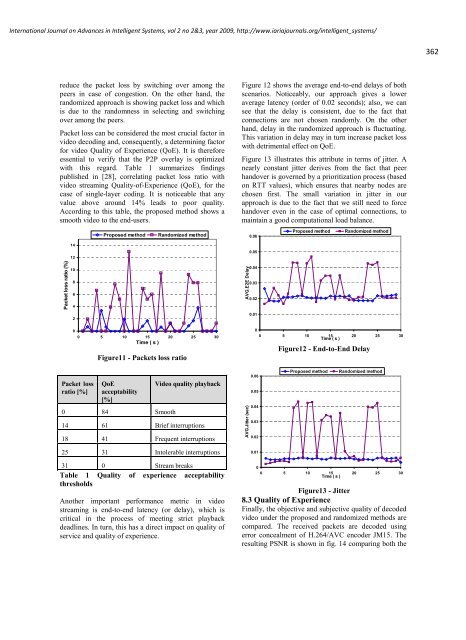Multimodal Robot/Human Interaction for Assisted Living
Multimodal Robot/Human Interaction for Assisted Living
Multimodal Robot/Human Interaction for Assisted Living
You also want an ePaper? Increase the reach of your titles
YUMPU automatically turns print PDFs into web optimized ePapers that Google loves.
International Journal on Advances in Intelligent Systems, vol 2 no 2&3, year 2009, http://www.iariajournals.org/intelligent_systems/<br />
reduce the packet loss by switching over among the<br />
peers in case of congestion. On the other hand, the<br />
randomized approach is showing packet loss and which<br />
is due to the randomness in selecting and switching<br />
over among the peers.<br />
Packet loss can be considered the most crucial factor in<br />
video decoding and, consequently, a determining factor<br />
<strong>for</strong> video Quality of Experience (QoE). It is there<strong>for</strong>e<br />
essential to verify that the P2P overlay is optimized<br />
with this regard. Table 1 summarizes findings<br />
published in [28], correlating packet loss ratio with<br />
video streaming Quality-of-Experience (QoE), <strong>for</strong> the<br />
case of single-layer coding. It is noticeable that any<br />
value above around 14% leads to poor quality.<br />
According to this table, the proposed method shows a<br />
smooth video to the end-users.<br />
Packet loss ratio (%)<br />
14<br />
12<br />
10<br />
8<br />
6<br />
4<br />
2<br />
0<br />
Packet loss<br />
ratio [%]<br />
Proposed method Randomized method<br />
c<br />
0 5 10 15 20 25 30<br />
Time ( s )<br />
Figure11 - Packets loss ratio<br />
QoE<br />
acceptability<br />
[%]<br />
0 84 Smooth<br />
Video quality playback<br />
14 61 Brief interruptions<br />
18 41 Frequent interruptions<br />
25 31 Intolerable interruptions<br />
31 0 Stream breaks<br />
Table 1 Quality of experience acceptability<br />
thresholds<br />
Another important per<strong>for</strong>mance metric in video<br />
streaming is end-to-end latency (or delay), which is<br />
critical in the process of meeting strict playback<br />
deadlines. In turn, this has a direct impact on quality of<br />
service and quality of experience.<br />
Figure 12 shows the average end-to-end delays of both<br />
scenarios. Noticeably, our approach gives a lower<br />
average latency (order of 0.02 seconds); also, we can<br />
see that the delay is consistent, due to the fact that<br />
connections are not chosen randomly. On the other<br />
hand, delay in the randomized approach is fluctuating.<br />
This variation in delay may in turn increase packet loss<br />
with detrimental effect on QoE.<br />
Figure 13 illustrates this attribute in terms of jitter. A<br />
nearly constant jitter derives from the fact that peer<br />
handover is governed by a prioritization process (based<br />
on RTT values), which ensures that nearby nodes are<br />
chosen first. The small variation in jitter in our<br />
approach is due to the fact that we still need to <strong>for</strong>ce<br />
handover even in the case of optimal connections, to<br />
maintain a good computational load balance.<br />
AVG.E2E Delay<br />
AVG.Jitter (sec)<br />
0.06<br />
0.05<br />
0.04<br />
0.03<br />
0.02<br />
0.01<br />
0<br />
0.06<br />
0.05<br />
0.04<br />
0.03<br />
0.02<br />
0.01<br />
0<br />
Proposed method Randomized method<br />
0 5 10 15 20 25 30<br />
Time ( s )<br />
Figure12 - End-to-End Delay<br />
Proposed method Randomized method<br />
0 5 10 15 20 25 30<br />
Time ( s )<br />
Figure13 - Jitter<br />
8.3 Quality of Experience<br />
Finally, the objective and subjective quality of decoded<br />
video under the proposed and randomized methods are<br />
compared. The received packets are decoded using<br />
error concealment of H.264/AVC encoder JM15. The<br />
resulting PSNR is shown in fig. 14 comparing both the<br />
362






